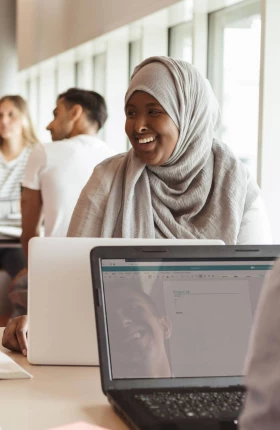When American K-12 public schools in all 50 states closed their doors in March 2020, the inequities and scale of the digital divide were abruptly unmasked. According to BCG research in 2020, coauthored with Common Sense, roughly 30% of children in grades K-12 (15 million to 16 million students) did not have adequate internet service or e-learning devices to effectively continue their schooling from home. While this is a challenge in every state, the digital divide most acutely affects students from rural and Southern communities. It also disproportionately affects Black, Latinx, and Native American students and those from lower-income households.
When the pandemic struck, many states and districts swiftly mobilized to address the needs of their digitally underserved students, often making use of the emergency funding authorized in March by the Coronavirus Aid, Relief, and Economic Security (CARES) Act. They purchased devices, hot spots, and other resources and partnered with providers to offer sponsored service at no cost to eligible households, among other initiatives. Yet BCG research showed that while these measures were significant, up to 12 million K-12 students nationwide remained inadequately connected at the start of 2021 and more than 75% of these efforts will expire in the next one to three years. Progress in serving these students was hampered by poor broadband mapping data, limitations of infrastructure and supply chains , insufficient marketing and adoption support, and inadequate funding.
Digital Access, Educational Inclusion, and Economic Opportunity
Even as students return to school in person, eliminating the digital divide for good is essential. Lack of access away from the school building contributes to significant curtailment of students’ learning, which translates to income losses that can last throughout their lives. Our research estimates that even when students are learning in the classroom, the lower lifetime income of the cohort of K-12 students caught in the digital divide will result in a $22 billion to $33 billion annual GDP loss. This number is likely to grow as learning at all levels continues to shift to digital platforms and jobs increasingly rely on digital skills.
The lower lifetime income of the current cohort of students caught in the digital divide will result in a $22 billion to $33 billion annual GDP loss.
Closing the digital divide and investing in innovative delivery that leverages digital connectivity is about stimulating step changes in pedagogy—unlocking new ways of learning and teaching students the skills essential to their future, next-generation jobs, and economic growth. With fully connected students and interactive technology tools and data, teachers can hone new models for teaching and learning; for instance, by unlocking more personalized learning pathways for students and analyzing data on learning progressions to tailor practices and enhance curricula.
To close the digital divide for good, we must address the three major barriers to access: affordability, availability, and adoption. Our research found that up to 60% of students without digital access (9 million), especially disconnected Black and urban students, are unable to afford it. Up to 25% (4 million) lack access to readily available and reliable broadband service, a barrier that disproportionately affects rural and Native American students. Finally, up to 40% (6 million) face adoption challenges such as digital literacy and language barriers. Many students face more than one barrier to adoption.
The Long Game for States and Districts
Since the adoption of the CARES Act, Congress has passed two other economic recovery bills: the Coronavirus Response and Relief Supplemental Appropriations Act of 2021 in December 2020 and the American Rescue Plan Act (ARP) in March 2021. This legislation includes additional funding for K-12 education that can be applied to a range of pandemic-related expenses, including distance learning, broadband-specific data collection, infrastructure deployment, service cost support, and other digital inclusion initiatives with a special focus on vulnerable communities. Notably, the ARP budgets more than $7 billion to expand the federal E-Rate connectivity program for schools and libraries to include delivering affordable connectivity directly into students’ homes.
These funds offer a unique opportunity for states and districts to lay the foundation for permanently eliminating the digital divide. Many are already doing so. More than 40 states now have offices dedicated to expanding broadband availability, affordability, and adoption—double the number of just a year ago.
To drive universal access, our analysis of strategies across the US highlights promising practices to replicate going forward.
Repeatable collection of data, with input from internet service providers, will help identify which providers could best service specific households.
- Create replicable data collection processes for needs assessments. Plan for repeatable collection of both student-level needs data through student information systems (SIS) and household-level coverage data, with input from internet service providers, to help inform and target solutions. Wisconsin’s Department of Public Instruction partnered with two education nonprofits and local providers to launch a data governance strategy in less than a month. They rolled out a survey using three SIS vendors serving 98% of schools in the state, and then securely overlaid data from broadband coverage maps to identify which providers could best service specific households.
- Reduce the cost of universal infrastructure deployment. Maximize use of available funds at the federal, state, and local levels for state projects. Decrease upfront investment costs, including lowering middle mile costs (the cost of connecting local internet service networks to the broader internet backbone). Coordinate broadband delivery through relevant frameworks, including “dig-once,” (a policy to reduce the number and scale of excavations for infrastructure), capacity leasing, and municipal network regulations. Consider a portfolio of strategies and technologies, such as satellites and mesh networks, especially in rural areas where fiber deployment may not be financially feasible. In the 1990s, North Dakota used federal funds to aggregate rural carriers into one statewide network. Their effort made rural broadband expansion in remote communities more financially attractive.
- Support affordable solutions with aggregated procurement. Create state- and district-level discounted or no-cost sponsored-service offerings to maximize volume discounts and minimize risk and churn for internet service providers (ISPs). Consider bundling broadband and device access for students. Alabama’s state-led voucher program covered the cost of installation, equipment, and service for up to 450,000 low-income students. The program focused on addressing upfront affordability challenges so that households were best positioned to take over ongoing service fees when the program ended. In addition, awareness and adoption campaigns promoting financial assistance programs—such as Lifeline, the recently launched Emergency Broadband Benefit, and rental assistance programs where broadband is an allowed expenditure—can help expand affordable access for students and the community at large.
- Engage stakeholders to support hard-to-reach families and address nonfinancial adoption barriers. Develop strategies to address barriers such as low digital and technical literacy . Trusted school districts and educators can play a focal role in the community, offering technical support and digital skills training for students, parents, and other residents. Chicago Connected, a multistakeholder partnership with schools and 35 community-based organizations, offers one-on-one assistance to families, including digital literacy training and internet adoption support. The program ensured that the voices of parents and community advocates were integral to the design and implementation process. The program continues to evolve; for example, a project-wide working group was set up to identify the digital literacy resources needed by applicants and participants.
Cross-Sector Stakeholder Strategies
Closing the divide requires strong policy direction and funding from federal, state, and local entities, as well as engagement and ongoing investment from stakeholders across the private and social sectors. The federal government, ISPs, school districts, education nonprofits, and philanthropies all have critical roles to play—individually and collectively.
Closing the divide requires strong policy direction and funding from government entities, as well as engagement and ongoing investment from stakeholders across the private and social sectors.
- Federal, state, and local policies can collectively unlock sustainable funding. This will ensure that there is transparent, affordable pricing for low-income families and support for broader digital inclusion and skill-building programs. These programs should incentivize tech-agnostic investment to establish broadband access where none exists and to expand connectivity where speeds are inadequate for remote learning or cost is a challenge.
- Broadband providers and device manufacturers can establish cost-effective offerings and invest in infrastructure to expand access and improve the quality of connections and devices. They must work jointly with local stakeholders to encourage adoption and support families and students.
- Philanthropies, EdTech companies, and education industry associations are critical catalysts of change and continuous improvement—for example, conducting ongoing research on family and learning needs and amplifying messages for specific groups or unifying them for all groups. The support and advocacy of these education sector players are crucial to inform policy and to stimulate ongoing investment in digitally enabled learning.
The Bigger Picture of the Digital Divide
While our three research reports on the digital divide in the US have focused mainly on K-12 students, it exists at all educational levels, affecting 3 million to 4 million US postsecondary students or about 15% of all students attending four-year private and public colleges and two-year community colleges. In addition, 20 million to 30 million US households that do not have children enrolled in primary or secondary schools cannot afford high-speed internet, do not have access to it in their communities, or have experienced other adoption barriers.
The same technical and economic challenges we found in the US are amplified many times over in countries with the largest populations living in extreme poverty. In India, more than 60% of the country’s 250 million pre-K-12 students do not have access to optimal educational technology in school or at home. During the early days of the pandemic, BCG worked with the National Institution for Transforming India and three state governments to expand connectivity and develop educational content across smartphones, television, and radio.
Although the global pandemic has been extremely disruptive for learning, it has greatly heightened awareness of the longer-term consequences of the digital divide throughout the world and stimulated both governments and the private sector to act. In the US, economic recovery funds, state- and district-level initiatives, and digital access commitments from ISPs have put society on the cusp of what could be a generational milestone—when all students and households have the technology and support they need to succeed. Federal momentum is growing to provide additional funding and support to ensure that this happens. President Biden’s proposed infrastructure plans include billions of dollars to fund initiatives that address racial and social inequities and deliver broadband access to every American.
As leaders in every country anticipate a post-COVID future, this is a unique moment to make transformative investments in K-12 education and beyond. Actions taken today to eliminate systemic inequities and to strengthen the connection between a solid formative education and economic opportunity can advance human well-being for years to come.











